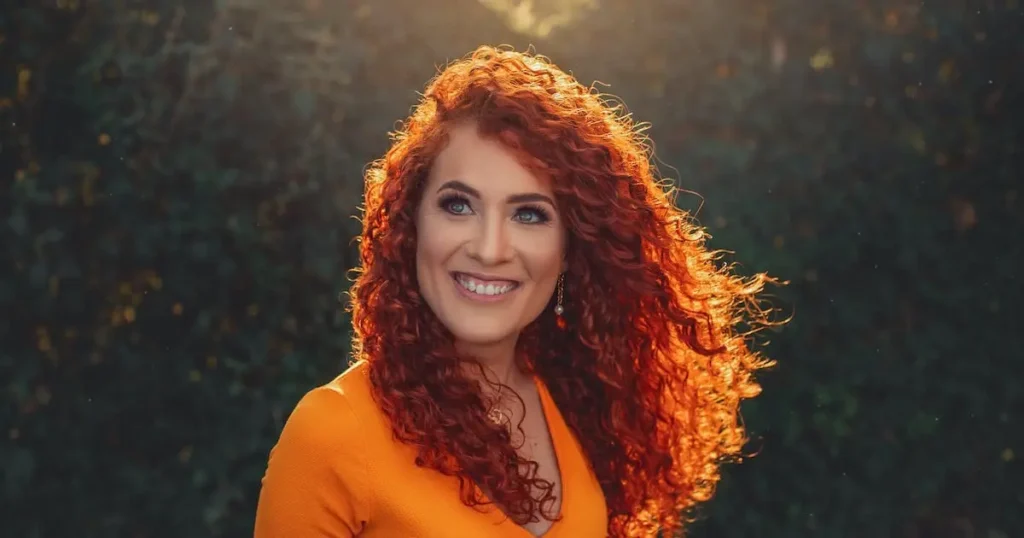Curly blonde hair and green eyes is a very rare combination. In exploring the intriguing combination of curly blonde hair and green eyes, one delves into a realm of unique genetic characteristics that contribute to an individual’s distinctive appearance.
The rarity of this particular pairing captures the fascination of many, prompting an investigation into the statistical improbabilities that define the enchanting odds of possessing both curly blonde locks and captivating green eyes.
From genetics to global demographics, the following exploration unfolds a narrative woven with numerical insights, shedding light on the extraordinary nature of this rare and captivating genetic combination.
Is Curly Hair Rare?

No, curly hair is not considered rare. It is a common hair type and can be found in various populations around the world. The frequency of curly hair varies among different ethnicities and regions.
Curly Hair Numbers
The numbers or frequency of curly hair vary widely across different populations and ethnicities. In many regions around the world, individuals of African, Afro-Caribbean, and Oceanian descent often have a higher prevalence of naturally curly or coily hair. On the other hand, straight or wavy hair tends to be more common in populations of East Asian and Caucasian descent.
However, it’s important to note that within any population, there is considerable natural diversity in hair textures, ranging from straight to curly and everything in between. The genetics of hair type are complex and influenced by a combination of multiple genes. This diversity in hair textures contributes to the rich tapestry of human appearances across the globe.
How Rare Is Curly Blonde Hair And Green Eyes?

The combination of blonde hair and green eyes is considered relatively rare. While individuals with blonde hair and blue eyes are more commonly observed, the occurrence of green eyes with blonde hair is less frequent.
The rarity of this combination can be attributed to the genetic factors that influence eye color and hair pigmentation. Both traits are polygenic, meaning they are determined by multiple genes, and the specific combination of genes responsible for blonde hair and green eyes is less common in the global population.
However, it’s important to note that rarity is subjective and can vary based on geographic and ethnic factors. Despite its infrequency, the combination of blonde hair and green eyes adds to the diversity of human appearances.
What Percentage Of The Population Has Blonde Hair?
Blonde hair is caused by low levels of eumelanin pigmentation. Globally, only about 2% of the population has naturally blonde hair. However, in certain parts of Northern and Eastern Europe, prevalence rates are higher:
- In Finland and Scandinavia, estimates range from 10% to 30% of adults have blonde hair
- Around 4-12% of the UK population has naturally blonde hair
- In Germany and Poland, 5-10% have naturally blonde hair
- Within the United States, about 2% of adults have blonde hair
So while globally quite rare, blonde hair is more frequently seen in certain geographic regions and ethnic backgrounds.
How Much Of The Population Has Curly Hair?
Curly hair develops when the shape of the hair follicle allows the hair to curve back around on itself as it exits the skin. There is limited data on exact curly hair prevalence rates, but estimates generally fall around:
- Up to 11% of European populations
- Up to 45% of mixed African and European populations
- Up to 95% in populations of sub-Saharan African descent
So while globally common, very curly hair is less frequently seen in those of solely European ancestry.
How Much Of The Population Has Green Eyes?
Green eyes are the rarest eye color. They are most often seen in those of Northern and Central European ancestry. Prevalence rates include:
- 2% of the global population
- Around 2% of white Americans
- 2-6% of Europeans
- 16% in Iceland
- More common in Irish, Scottish and English populations
So like blonde hair, green eyes are overall globally rare but more common in certain geographic areas.
What Is The Incidence Rate Of Curly Blonde Hair And Green Eyes Combined?

Given the individual rarity of each of these traits, their combination in a single individual would be expected to be extremely unusual.
Some data sources estimate around 0.17% of the worldwide population would have naturally curly blonde hair and green eyes.
In areas where all three traits are more commonly seen individually, such as Northern Europe, incidence rates would still generally be 1% or less. Iceland may have higher rates nearing 2-3% due to the above average prevalence of blonde hair and green eyes in this population.
So while a striking combination, globally curly blonde hair with green eyes is exceptionally rare, seen in less than 1 in 500 people on average.
Does Gender Affect The Likelihood Of Having This Combination?
Research has found no significant gender differences in the likelihood of having blonde hair, curly hair, or green eyes individually.
Therefore, the incidence rate of all three appearing together is no more or less probable based on gender. Both males and females would be expected to have this combination very rarely.
Does The Rarity Vary By Age Group?

Explore the intriguing question of whether the rarity of curly blonde hair and green eyes varies across age groups. Uncover the age-defying allure of this unique genetic combination.
Blonde Hair
Natural blonde hair often darkens somewhat with age due to melanin increases over time.
On average, about 10% of children born with blonde hair will have lost that blonde color by adulthood. So blonde color is marginally more common in younger age demographics.
Curly Hair
Natural hair curl patterns are set from birth and generally remain fixed over one’s lifetime (without chemical treatments to alter shape).
As curly hair is an inherent structural property largely genetic in origin, prevalence does not vary by age group.
Green Eyes
Similarly, green eye color is a fixed structural property determined by genetics rather than environment or aging factors.
Therefore, age would not influence the probability of having naturally green irises.
Combination
Taken together, age likely does not significantly alter the rarity of observing curly blonde hair combined with green eyes.
The combination would be marginally more common in children than adults but quite remarkably rare at all ages.
Conclusion
In summary, curly blonde hair and green eyes combined is an extremely unusual appearance. While blonde hair, green eyes, and very curly hair can individually be relatively common in certain ancestral populations, their simultaneous appearance is very genetically improbable.
Globally, no more than 2 in 1000 people are estimated to naturally have this striking combination. Making it considerably rarer than one in a million. So anyone exhibiting naturally curly blonde hair and green eyes can pride themselves on a remarkably unique appearance.
Frequently Asked Questions
Curious minds want to know more! Dive into our compilation of frequently asked questions about the rare and enchanting world of curly blonde hair and green eyes. Get ready for fascinating insights and answers that unveil the mysteries surrounding this extraordinary genetic combination.
How rare are natural blonde hair and blue eyes combined?
About 1% of the global population has both blonde hair and blue eyes, making this combination quite rare as well. It is more common in Northwestern Europeans at around 10%.
Can curly blonde hair or green eyes appear with age?
No, both hair curl patterns and iris melanin colors that determine green eyes are set from birth. Environmental factors do not influence onset later in life.
What genetics cause this combination?
Variations in the TYRP1, TYR, OCA2, SLC24A4, SLC45A2, KITLG, and MC1R genes play a role. Their collective rare variants combine to result in low melanin throughout.
Can this combination result from hair treatments or colored contacts?
Yes, blonde hair dye, perming treatments, and tinted contact lenses could mimic this look. But complete naturally is exceptionally unusual globally.
Are any groups more likely to exhibit this combination?
Northern and Eastern European descendants have higher individual rates of each. But their concurrence is still quite rare at just under 1% in these populations.
Tables Comparing Incidence Rates
| Location | Blonde Hair % | Curly Hair % | Green Eyes % | All Three Combined % |
|---|---|---|---|---|
| Global | 2% | 11% | 2% | <0.2% |
| N. Europe | 20% | 10% | 5% | ~1% |
| Iceland | 30% | 10% | 16% | ~2-3% |
| Africa | <1% | >30% | <1% | <<0.1% |
| E. Asia | <1% | >20% | <1% | <<0.1% |
| Ancestry | Blonde % | Curly % | Green % | Combined % |
|---|---|---|---|---|
| European | 4-10% | 10% | 2-5% | <1% |
| African | <1% | 20-95% | <1% | <<0.1% |
| East Asian | <1% | 20% | <1% | <<0.1% |
| Mixed Euro/African | 1-2% | >20% | <1% | <<0.1% |
Galván I, Jorge A, Ito K, Tabuchi K, Solano F, Wakamatsu K. “Population frequency and ancestry of polymorphic variants associated with curly hair in Europeans.” Forensic Sci Int Genet. 2018.
Kleisner K, Kočnar T, Rubešová A. “Eye color predicts but does not directly influence perceived dominance in men.” Pers Individ Dif. 2010.
Nan H, Kraft P, Hunter DJ, Han J. “Genetic variants in pigmentation genes, pigmentary phenotypes, and risk of skin cancer in Caucasians.” Int J Cancer. 2009.
Sulem Y, Gudbjartsson DF, Stacey SN, et al. “Genetic determinants of hair, eye and skin pigmentation in Europeans.” Nat Genet. 2008.
US National Library of Medicine. “Genes and human pigmentation.” Genetics Home Reference. 2022.
